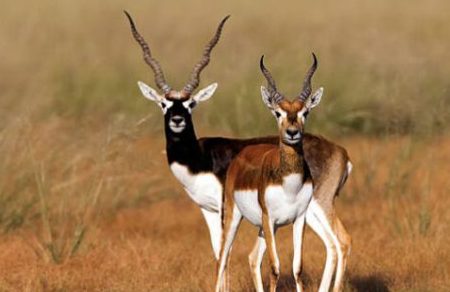Buguda: Population of the endangered blackbuck in Ganjam district has increased by 1,191 during the last four years, a census report of the forest department said.
Notably, Ganjam is home to a common species of the Indian antelope i.e. blackbuck.
In Ganjam district, this kind of Indian antelope is commonly found in the areas of Bhetnoi in Aska block and Balipadar of Buguda block. Besides, Aska and Buguda this animal is also found in Polsara, Khalikot and Jagannathprasad blocks.
It may be mentioned here that this Indian antelope-type (Antelope Cervicapra) is also known as ‘Krishnasara’ or ‘Baliharina’ and even ‘Kala Barisia’ in different pockets of the district.
The lifespan of a blackbuck is typically 10 to 15 years. While the males have an average weight of 34-45 kg, females weigh around 31-39 kg and are only a little shorter than the males.
The males at their initial stage are brown in colour, without horns. However, with secretion of sexual hormones, males develop a pair of un- branched, ‘corkscrew’ horns on each side of head and change their body colour to elegant black. The beautiful spiral horns, which never shed like deer’s antlers, may grow up to 50 cm. The colour of the body coat is light yellow for young females. Both males and females have white patches around their eyes, on their inner legs, mouth, underside, and on the rump.
Blackbucks live on fresh tender leaves, grass, crops, cereals, vegetables and leaves of shrubs and trees. They feed for a long time, and select succulent grasses, tender shoots of crops and plants, which help them to maintain water balance in their bodies. They can survive without drinking water for a day to a week.
The forest departments under Aska and Buguda ranges have constructed more than ten ponds for drinking purposes of the endangered species. For the approaching summer season, pits have been arranged for the blackbucks in the forest area. Every year, the forest department cultivates grass on both government and private lands for the blackbucks to feed on them.
Moreover, the blackbucks in these areas are protected religiously by the locals. The belief that the presence of blackbucks in the paddy fields brings prosperity to the villagers has greatly contributed to the conservation of this species. The villagers do not kill the animal even if it strays into the fields and grazes their crop.
As the story goes— more than a century ago, there was a long spell of drought in the area. During this period, a small group of blackbucks appeared here after which it rained and the drought spell was broken. Since then, people have started protecting these animals devotedly as they feel that their fate is linked with these blackbucks.
In 1918, Madeshi Chandramani Dora, a British, took an initiative for the protection of these species and published a notification in an Odia newspaper for prohibiting killing of blackbucks.
Generally, blackbucks prefer to remain in groups while grazing. Two or three male blackbucks lead the group of 15 to 20 female blackbucks. Sometimes war takes place among the male blackbucks for the females. In the wars, either one of the male blackbucks dies or leaves the area.
These animals reproduce two young ones in a year and carry their baby for six months. They prefer bushes and stems to give birth to their babies.
The forest department and 70 villagers in the district collectively formed a committee named as ‘Blackbuck Conservation Committee’ for the security of the endangered species. However, road accidents have been a major reason for their reduced numbers.
When asked, South Ghumusara Forest Range official, Satya Narayan Behura, said, “We have been trying to save the blackbucks always. We always take care that the blackbucks are not be infected with any disease.”
Population of blackbucks for last 4 years below:
Year Male Female Young Total
2011 386 993 154 1533
2015 782 1490 346 2718
2018 812 1669 328 2809
2020 breakdown no. not provided 4000
PNN

